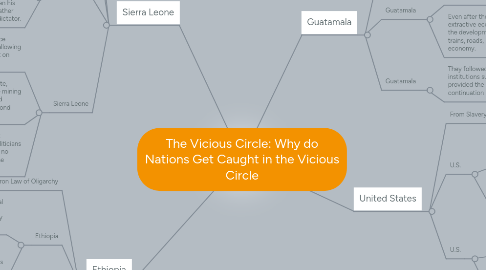
1. Sierra Leone
1.1. You Can't Take the Train to Bo anymore
1.2. Sierra Leone
1.2.1. Started off as a British Colony. The British identified African Rulers and gave them a new title "paramount chief
1.2.2. When Sierra Leone became independent in 1961, the British gave power to Sir Milton Margai and his Sierra Leone People's Party (SlPP). In 1967, they lost power to the All People's Congress Party (APC) led by Siaka Stevens
1.3. Sierra Leone
1.3.1. The railway was used for transporting coffee, cocoa, and diamonds. The farmers who grew coffee and cocoa were Mende. When Stevens was elected he took away the railway and this had a huge negative impact on the economy.
1.3.2. He was afraid that the railways would strengthen his opponents so he chose to consolidate power rather than grow the economy. He became a violent dictator.
1.4. Sierra Leone
1.4.1. Agricultural productivity failed because the Produce Marketing Board set fixed profits for farmers, not allowing the markets to control the prices. Negative impact on incentives for famers.
1.4.2. The British had set up a monopoly for the entire protectorate, called the Sierra Leone Selection Trust, and it governed the mining sector. In the 1950's this company became nationalized and Steven's was able to take control of the profits of the diamond industry.
1.4.3. Sierra Leone got caught in the vicious circle. The British built extractive institutions, and the post-independent African politicians took control afterwards. The extractive institutions provided no checks against the abuse of power, and created great income inequality
2. Ethiopia
2.1. The Iron Law of Oligarchy
2.2. Ethiopia
2.2.1. The Iron Law of Oligarchy: Created by Robert Michels, an internal logic of oligarchies is that they will reproduce themselves not only when the same group is in power, but even when an entirely different group takes control
2.2.2. The Solomonic dynasty lasted in Ethiopia until it was overthrown in 1974. Emperor Haile Selassie presided over an extreme set of extractive institutions and ran the country as his own private property. There was not economic development
2.3. Ethiopia
2.3.1. In December of 1974, The Derg, initially formed out of 108 representatives of different military units from all over the country, overthrew the dynasty and declared Ethiopia a socialist state
2.3.2. By 1978, Major Mengistu was the unchallenged leader of the Derg. As his residence, he chose Selassie's Grand Palace. He began comparing himself to Emperor Tewofros, who had refounded the Solomonic Dynasty. There was a complete reversal of ideas from the revolution. Mengistu became the sole ruler.
3. Guatamala
3.1. From Encomienda to Land Grab
3.2. Guatamala
3.2.1. Encomienda: the indigenous people were allocated to the conquistadors in grants. A system of forced labor. This allowed the elite to monopolize the economy
3.2.2. Even after the new constitution, Rafael Carrera (1839-1871) continued the extractive economic institutions, exploiting the labor of Guatemala. He resisted the development of infrastructure, because of creative destruction. They refused trains, roads, and other methods of transportation that would have grown the economy.
3.3. Guatamala
3.3.1. They followed the typical pattern of the vicious circle. Political institutions supported extractive institutions, which in turn provided the basis for extractive political institutions and the continuation of the power of the same elite.
4. United States
4.1. From Slavery to Jim Cros
4.2. U.S.
4.2.1. The extractive institution of slavery in the South monopolized the labor economy, and after the Civil War, the vicious circle continued with the Jim Crow Laws.
4.2.2. The former slave owners profited from cheap labor from the newly freed slaves
4.3. U.S.
4.3.1. The southern elite continued their monopoly by working with political institutions, including the presidential elections, as well as state and local government elections. They instituted poll taxes and literacy tests for voting. They effectively created an apartheid society, where blacks and white lived different lives
4.3.2. The circle continued because the southern planter elite controlled power in economic and political institutions
